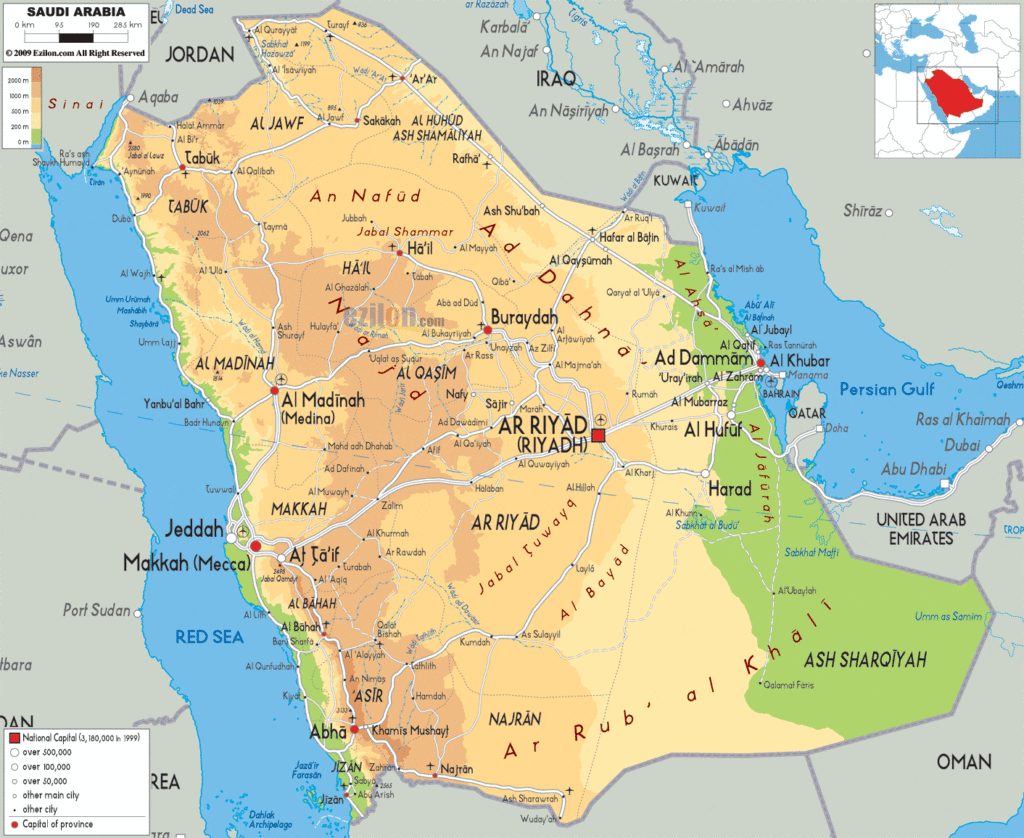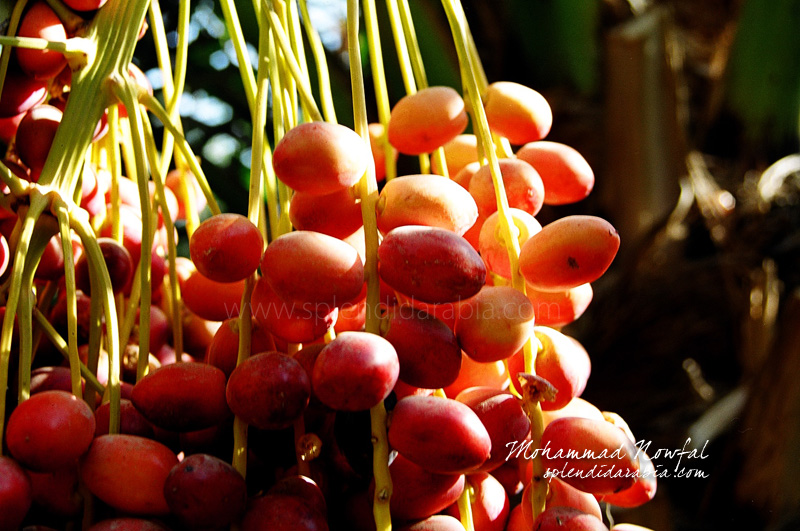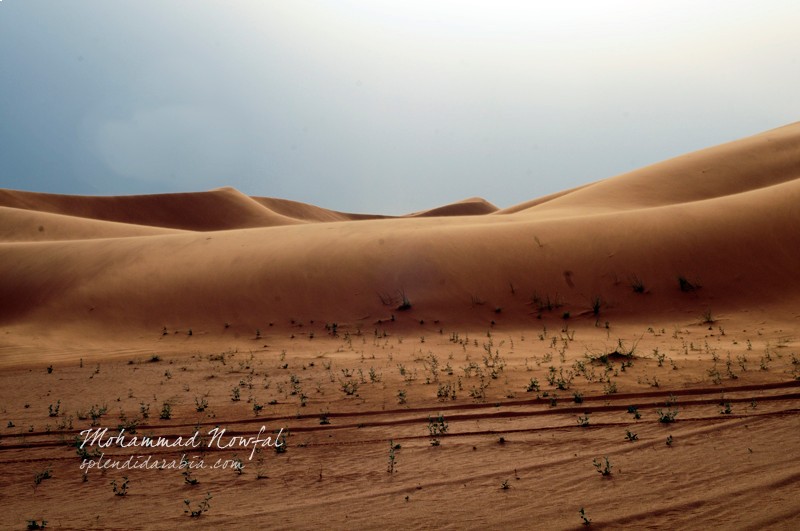Date, a fruit cultivated extensively throughout the world in hot, …
Rulers of Saudi Arabia
A synopsis
The real picture of the Kingdom of Saudi Arabia is largely unknown to rest of the world though its history goes back to mists of time. Most of the images of the Kingdom known to the outer world were a cocktail of myth and reality written by early travelers. Saudi Arabia has exquisitely varied landscapes, of mountain peaks, enormous oasis, escarpments, gorgeous caves, seas, deserts, canyons, plateaus and beautiful coastlines. In addition to these, Saudi Arabia is historically and archaeologically rich. Archaeological evidence indicates that man lived in different regions of Saudi Arabia since PREHISTORIC times. An area of around 2,250,000 square kilometers, Saudi Arabia is a loosely populated country with 2,640 kilometers of coastline with rich marine fauna, mountains up to the height of 10,522 feet and vast deserts with an estimated area of about 650,000 sq km.
Map of Saudi Arabia
The Kingdom of Saudi Arabia (Al-Mamlaka al-Arabiya as-Saudiya / KSA) or shortly called Saudi Arabia in southwestern Asia is bordered on the north by Jordan, Iraq, and Kuwait; on the east by the Arabian Gulf (Persian Gulf), Qatar, Bahrain, and the United Arab Emirates; on the southeast by Oman; on the south by the Republic of Yemen; and on the west by the Red Sea and the Gulf of Aqabah.
Saudi Arabia is part of the Arabian Peninsula which consists of Bahrain, Kuwait, Oman, Qatar, Saudi Arabia, UAE, and Yemen.


Out of the seven countries, the Kingdom of Saudi Arabia covers the greater part of the peninsula. With the exclusion of Yemen (the sole republic on the peninsula), the rest of six countries are know as the Arab Gulf States.
With the presence of Makkah and Madinah, the two holy places of Muslims, Saudi Arabia is called “the land of the two holy mosques” and its king “the custodian of the two holy mosques”
The Kingdom has an area of 2,250,000 square Kilometers (868,730 square miles), which is almost two-third the size of India. The figure varies due to the undefined boundaries of some of its neighboring countries.
Geographically, Saudi Arabia is divided into four major regions – Central, Eastern, Western and Southern.
Western Saudi Arabia is dominated by the mountain chain running the entire length of the country parallel to the Red Sea, raises between 1300 to more than 3000 meters. From this fertile crest it falls towards the east as a desert plateau to the dry interior or the Nejd containing the great sand deserts of the Empty Quarter, Great Nafud and Ad Dahna. The eastern region lies on the Persian Gulf Cost and contains salt flats.
The Great Nafud Desert in the north and the Rub Al Khali (The Empty Quarter), one of the largest sand deserts in the world, in the south form large stretches of sand dunes. The two great deserts are connected by a belt of narrow sand dunes known as Ad Dahna, converting nearly a third of the surface area of Saudi Arabia into the sand desert.
Saudi Arabia, the world’s largest oil-producing country, alone holds nearly 25 percent of the world’s crude oil reserves.
Saudi Rulers from the Unification till the present day
King Abdul Aziz bin Saud (1880–1953)
Founder & First King of Saudi Arabia (1932-1953)
A charismatic leader and statesman, a great warrior, superb conversationalist and debater, and most eloquent in all his speeches. He was the first King of unified Saudi Arabia.
Exiled to Kuwait by the House of Ar Rashid (a dynasty centered in Hail) at the age of 10 with his family in 1890, young Abdul Aziz returned to Riyadh after 10 years with a small band of trusted companions on an expedition to recapture the city from Ar Rashidi.
On 15 January 1902 he recaptured Riyadh by defeating Ar Rashidi, fought guerrilla warfare against the Ottomans and completed his conquest of Najd and eastern coast in 1912. In 1925 the forces of Ibn Saud captured the holy city of Mecca and On 10 January 1926, he proclaimed himself King of the Hejaz. In 1932, after conquering most of the Peninsula, he renamed his dominions “Saudi Arabia” and proclaimed himself “King of Saudi Arabia”. He died in Taif and buried in Riyadh in an unmarked grave.
King Saud bin Abdul Aziz bin Saud (1902-1969)
2nd King (1953-1964)
A charismatic leader and statesman, a great warrior, superb conversationalist and debater, and most eloquent in all his speeches. He was the first King of unified Saudi Arabia.
Exiled to Kuwait by the House of Ar Rashid (a dynasty centered in Hail) at the age of 10 with his family in 1890, young Abdul Aziz returned to Riyadh after 10 years with a small band of trusted companions on an expedition to recapture the city from Ar Rashidi.
On 15 January 1902 he recaptured Riyadh by defeating Ar Rashidi, fought guerrilla warfare against the Ottomans and completed his conquest of Najd and eastern coast in 1912. In 1925 the forces of Ibn Saud captured the holy city of Mecca and On 10 January 1926, he proclaimed himself King of the Hejaz. In 1932, after conquering most of the Peninsula, he renamed his dominions “Saudi Arabia” and proclaimed himself “King of Saudi Arabia”. He died in Taif and buried in Riyadh in an unmarked grave.
King Faisal bin Abdul Aziz bin Saud (1905-1975)
3rd King (1964-1975)
The third son of the first King of Saudi Arabia, Faisal bin Abdul Aziz successfully stabilized the kingdom’s bureaucracy and his reign had significant popularity among Saudis.
He gave a great deal of attention to the economic, financial, industrial and agricultural sectors. During his era, agricultural land area increased rapidly and the search for water sources was encouraged.
An internationally recognized personality, a powerful leader, an exceptional statesman, a respected diplomat and a good philanthropist, King Faisal successfully modernized Saudi Arabia without compromising the country’s Islamic identity.
He maintained the Bedouin custom of the Majlis or audience and by that he made himself available to all his subjects. He was assassinated in 1975.
King Khalid bin Abdul Aziz bin Saud (1913-1982)
4th King (1975-1982)
Khalid was named Crown Prince in 1965, after his older brother (and only full brother) Muhammad bin Abdul Aziz Al Saud declined a place in the succession. He was not very interested in politics, as King, he delegated effective control of the country to his half-brother, Crown Prince Fahd.
He followed the policies of his predecessor, King Faisal bin Abdul Aziz.
He was successful in leading the Kingdom through seven years of prosperity and development, overcoming the challenges posed by a global economic crisis. He died of a heart attack.
King Fahad bin Abdul Aziz bin Saud (1923-2005)
5th King (1982-2005)
Founder of the Kingdom’s modern educational system, King Fahad, was 9 years old when the Kingdom was founded in 1932.
He was a man of great vision and leadership who inspired the countrymen for a quarter of a century as king. King Fahad became the longest ruled King of Saudi Arabia.
In 1986 King Fahd adopted the title of ‘Custodian of the Two Holy Mosques’ in preference to the title of His Majesty.
Aware that the Holy Mosque could not support the growing numbers of worshippers, he initiated a refurbishment and expansion program. He invited US troops into Saudi Arabia in 1990 to counter the threat of Iraqi invasion that was strongly criticized within the country.
Died in 2005 and buried in Riyadh in an unmarked grave.
King Abdullah bin Abdul Aziz bin Saud (1924-2015)
6th King (2005-2015)
King Abdullah was a great Saudi leader who gained international respect as a wise man of values and morals. One of the most influential personalities and statesman whose work profoundly marked the history of Saudi Arabia.
A great visionary leader who led the Kingdom to new heights of glory.
A King of humanity, he was loved by all nationals in the Kingdom. The biggest challenge the King had in his career was to get the economy back into shape and end the isolation Saudi Arabia had faced in the international world after 9/11. He took drastic measures and bold decisions. He united his people by launching national dialogue.
He set aside a major part of the budget for education and health care.
He will always be remembered for his massive projects for the nation including King Abdullah University of Science and Technology (KAUST), Princes Noura bint Abdul Rahman University (the largest university for women in the world), Introduction of Haj Metro for pilgrims, The biggest historic expansion of The Grand Mosque in Makkah, Riyadh Metro, railway lines around the Kingdom connecting major cities, Financial cities are to be named a few. And, his achievements include Arab Peace Initiative, membership of the World Trade Organization and the introduction of human rights organizations to name a few.
The King bred pure Arabian horses, and founded the Riyadh Equestrian Club. He loved to read and established the King Abdul Aziz Library in Riyadh.
The King passed away on Friday, 23rd January 2015. He was buried in Al-Oud cemetery in Riyadh after the funeral prayer led by Grand Mufti Sheikh Abdul Aziz A-Asheikh at Imam Turki bin Abdullah Mosque at Deerah in Riyadh.
King Salman bin Abdul Aziz bin Saud (1935)
7th and the Ruling King of Saudi Arabia (2015)
Salman bin Abdul-Aziz Al Saud (Salman bin Abdulaziz bin Abdul Rahman bin Faisal bin Turki bin Abdullah bin Mohammed bin Saud), Custodian of the Two Holy Mosques, is the ruling King of Saudi Arabia.
An experienced administrator and statesman, King Salman had been Governor of Riyadh for the past 56 years. He led a corruption-free administration of Riyadh Province and did tremendous contribution to the development of the Province.
He has good relationship with world leaders since many years and held wide-ranging talks around the globe as a Crown Prince since 2012. As a philanthropist, King Salman is a trusted mediator in settling conflicts and a winner of several honors. The King’s long journey continues that started at the age of 19 when he was appointed as acting governor of Riyadh on March 17, 1954!
Mohammed bin Salman (1985)
Crown Prince (2017), Deputy Prime Minister and Defense Minister (2015)
Mohammed bin Salman, the youngest minister of defense in the world, has been appointed as the crown prince of Saudi Arabia on 21 June 2017. He is the young architect of the Kingdom’s vision of the future, Vision 2030.
In December 2009, Mohammad bin Salman entered politics as a special adviser to his father when the latter was the governor of Riyadh Province.
On the death of King Abdullah on 23 January 2015, Salman bin Saud took the throne and Prince Mohammad was appointed minister of defense. He was also named as the secretary general of the Royal Court on the same date.
Chairman of MiSK Foundation (Prince Mohammed bin Salman bin Abdulaziz Philanthropic Foundation) which is a non-profit foundation aiming to help disadvantaged youth. The Foundation has been partner of the 9th UNESCO Youth Forum for Change in 2015.
The Foundation focuses on the country’s youth and provides different means of fostering talent, creative potential, and innovation in a healthy environment that offers opportunities in arts and sciences. The Foundation pursues these goals by establishing programs and partnering with local and global organizations. It intends to develop intellectual capability in youth, as well as unlock the potential of all Saudi people.
“The Iron of the West without its ideas”
The present kingdom of Saudi Arabia derives its existence from the campaigns of its founder, Abdul Aziz bin Abdul Rahman Al Saud ( also known as Ibn Saud), who initially captured Riyadh with his Bedouin followers in 1902. Thereafter, with the aid of the Ikhwan (literally means brotherhood, the Ikhwan was the Islamic religious militia which formed the main military force of Ibn Saud. They were made up of Bedouin warriors), he recaptured the rest of Najd, defeating the Al Rashid forces at Hail in the north in 1921, and conquering the Hijaz, including Mecca and Medina in 1924. He was chosen as king of Hijaz and Najd in 1927.
It was in 1932 that Abdul Aziz bin Saud proclaimed the Kingdom of Saudi Arabia. By the discovery of oil in 1938, the lives of the kingdom’s inhabitants were ultimately transformed. The King sought to make use of Western technology but at the same time strove to maintain the traditional institutions associated with Islamic and Arab life that he phrased as “the iron of the West without its ideas”.
Related Articles
The Desert is the most prominent feature of the Arabian …
Splendid Arabia travel & trekking videos Dakar Rally 2020 In …
Seasons in Saudi Arabia Saudi Arabia has mainly two seasons: …
The prevailing image of Saudi Arabia is that of a country …
The Flag of Saudi Arabia The Saudi Arabian flag that …






